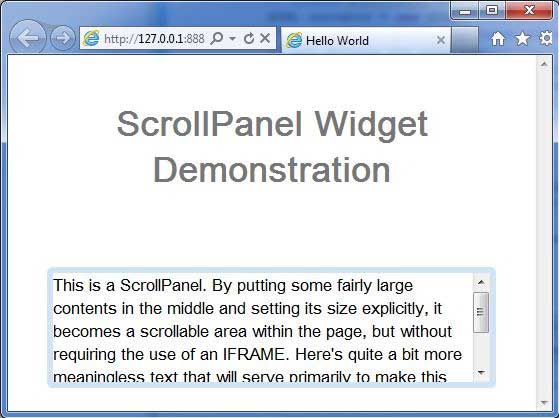
- GWT - Home
- GWT - Overview
- GWT - Environment Setup
- GWT - Applications
- GWT - Create Application
- GWT - Deploy Application
- GWT - Style with CSS
- GWT - Basic Widgets
- GWT - Form Widgets
- GWT - Complex widgets
- GWT - Layout Panels
- GWT - Event Handling
- GWT - Custom Widgets
- GWT - UIBinder
- GWT - RPC Communication
- GWT - JUnit Integration
- GWT - Debugging Application
- GWT - Internationalization
- GWT - History Class
- GWT - Bookmark Support
- GWT - Logging Framework
GWT - ScrollPanel Widget
Introduction
The ScrollPanel widget represents a simple panel that wraps its contents in a scrollable area.
Class Declaration
Following is the declaration for com.google.gwt.user.client.ui.ScrollPanel class −
public class ScrollPanel
extends SimplePanel
implements SourcesScrollEvents, HasScrollHandlers,
RequiresResize, ProvidesResize
Class Constructors
| Sr.No. | Constructor & Description |
|---|---|
| 1 |
ScrollPanel() Creates an empty scroll panel. |
| 2 |
ScrollPanel(Widget child) Creates a new scroll panel with the given child widget. |
Class Methods
| Sr.No. | Function name & Description |
|---|---|
| 1 |
HandlerRegistration addScrollHandler(ScrollHandler handler) Adds a ScrollEvent handler. |
| 2 |
void addScrollListener(ScrollListener listener) Deprecated. Use addScrollHandler(com.google.gwt.event.dom.client.ScrollHandler) instead |
| 3 |
void ensureVisible(UIObject item) Ensures that the specified item is visible, by adjusting the panel's scroll position. |
| 4 |
protected Element getContainerElement() Override this method to specify that an element other than the root element be the container for the panel's child widget. |
| 5 |
int getHorizontalScrollPosition() Gets the horizontal scroll position. |
| 6 |
int getScrollPosition() Gets the vertical scroll position. |
| 7 |
void onResize() This method must be called whenever the implementor's size has been modified. |
| 8 |
void removeScrollListener(ScrollListener listener) Deprecated. Use the HandlerRegistration.removeHandler() method on the object returned by addScrollHandler(com.google.gwt.event.dom.client.ScrollHandler) instead |
| 9 |
void scrollToBottom() Scroll to the bottom of this panel. |
| 10 |
void scrollToLeft() Scroll to the far left of this panel. |
| 11 |
void scrollToRight() Scroll to the far right of this panel. |
| 12 |
void scrollToTop() Scroll to the top of this panel. |
| 13 |
void setAlwaysShowScrollBars(boolean alwaysShow) Sets whether this panel always shows its scroll bars, or only when necessary. |
| 14 |
void setHeight(java.lang.String height) Sets the object's height. |
| 15 |
void setHorizontalScrollPosition(int position) Sets the horizontal scroll position. |
| 16 |
void setScrollPosition(int position) Sets the vertical scroll position. |
| 17 |
void setSize(java.lang.String width, java.lang.String height) Sets the object's size. |
| 18 |
void setWidth(java.lang.String width) Sets the object's width. |
Methods Inherited
This class inherits methods from the following classes −
com.google.gwt.user.client.ui.UIObject
com.google.gwt.user.client.ui.Widget
com.google.gwt.user.client.ui.Panel
com.google.gwt.user.client.ui.SimplePanel
java.lang.Object
ScrollPanel Widget Example
This example will take you through simple steps to show usage of a ScrollPanel Widget in GWT. Follow the following steps to update the GWT application we created in GWT - Create Application chapter −
| Step | Description |
|---|---|
| 1 | Create a project with a name HelloWorld under a package com.tutorialspoint as explained in the GWT - Create Application chapter. |
| 2 | Modify HelloWorld.gwt.xml, HelloWorld.css, HelloWorld.html and HelloWorld.java as explained below. Keep rest of the files unchanged. |
| 3 | Compile and run the application to verify the result of the implemented logic. |
Following is the content of the modified module descriptor src/com.tutorialspoint/HelloWorld.gwt.xml.
<?xml version = "1.0" encoding = "UTF-8"?> <module rename-to = 'helloworld'> <!-- Inherit the core Web Toolkit stuff. --> <inherits name = 'com.google.gwt.user.User'/> <!-- Inherit the default GWT style sheet. --> <inherits name = 'com.google.gwt.user.theme.clean.Clean'/> <!-- Specify the app entry point class. --> <entry-point class = 'com.tutorialspoint.client.HelloWorld'/> <!-- Specify the paths for translatable code --> <source path = 'client'/> <source path = 'shared'/> </module>
Following is the content of the modified Style Sheet file war/HelloWorld.css.
body {
text-align: center;
font-family: verdana, sans-serif;
}
h1 {
font-size: 2em;
font-weight: bold;
color: #777777;
margin: 40px 0px 70px;
text-align: center;
}
Following is the content of the modified HTML host file war/HelloWorld.html.
<html>
<head>
<title>Hello World</title>
<link rel = "stylesheet" href = "HelloWorld.css"/>
<script language = "javascript" src = "helloworld/helloworld.nocache.js">
</script>
</head>
<body>
<h1>ScrollPanel Widget Demonstration</h1>
<div id = "gwtContainer"></div>
</body>
</html>
Let us have following content of Java file src/com.tutorialspoint/HelloWorld.java which will demonstrate use of ScrollPanel widget.
package com.tutorialspoint.client;
import com.google.gwt.core.client.EntryPoint;
import com.google.gwt.user.client.ui.DecoratorPanel;
import com.google.gwt.user.client.ui.HTML;
import com.google.gwt.user.client.ui.RootPanel;
import com.google.gwt.user.client.ui.ScrollPanel;
public class HelloWorld implements EntryPoint {
public void onModuleLoad() {
// Create scrollable text
HTML contents = new HTML("This is a ScrollPanel."
+" By putting some fairly large contents in the middle"
+" and setting its size explicitly, it becomes a scrollable area"
+" within the page, but without requiring the use of an IFRAME."
+" Here's quite a bit more meaningless text that will serve primarily"
+" to make this thing scroll off the bottom of its visible area."
+" Otherwise, you might have to make it really, really"
+" small in order to see the nifty scroll bars!");
//create scrollpanel with content
ScrollPanel scrollPanel = new ScrollPanel(contents);
scrollPanel.setSize("400px", "100px");
DecoratorPanel decoratorPanel = new DecoratorPanel();
decoratorPanel.add(scrollPanel);
// Add the widgets to the root panel.
RootPanel.get().add(decoratorPanel);
}
}
Once you are ready with all the changes done, let us compile and run the application in development mode as we did in GWT - Create Application chapter. If everything is fine with your application, this will produce following result −
